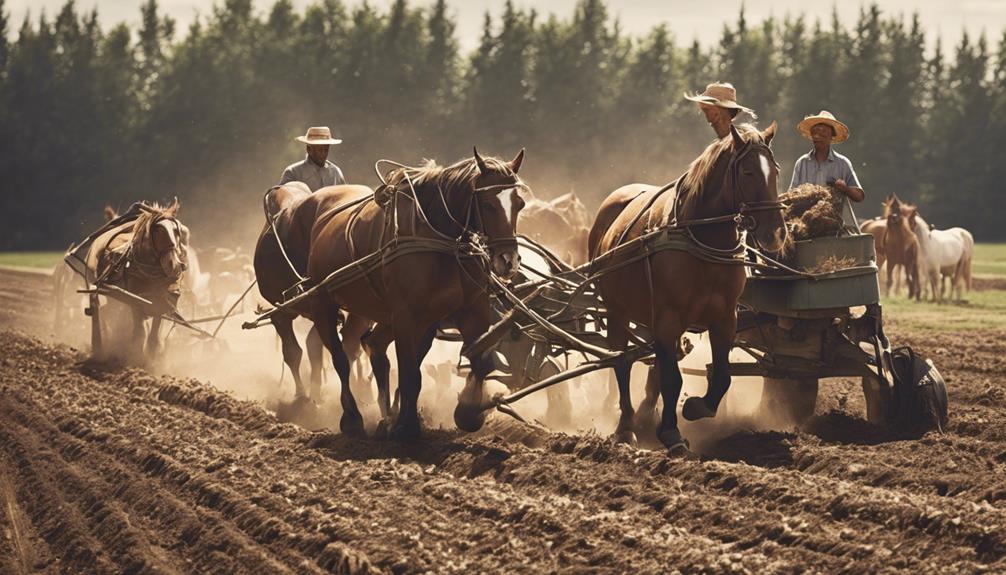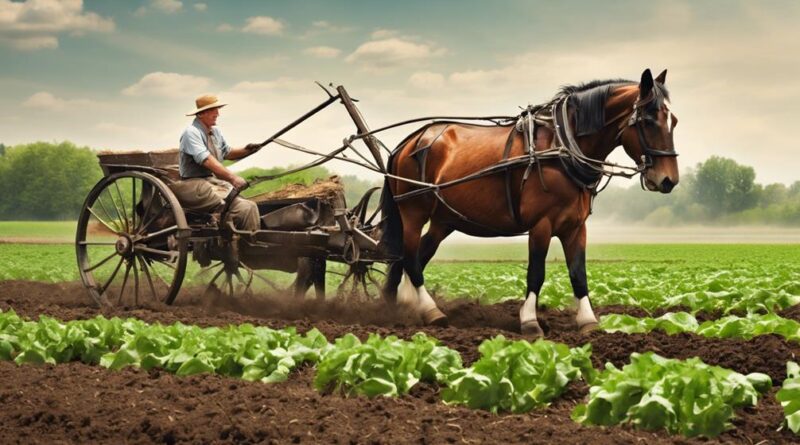Why Did Horses Revolutionize Agricultural History?
Horses, often referred to as the 'equine game-changers,' played a pivotal role in transforming the landscape of agricultural practices. From enhancing productivity to enabling the development of new techniques, these majestic creatures left an indelible mark on history.
But what exactly was it about horses that sparked such a profound revolution in the realm of agriculture?
Early Domestication of Horses
During ancient times, humans tamed wild horses for various tasks, marking the beginning of the early domestication of these majestic animals. The process of horse breeding became essential as people realized the benefits of selectively pairing horses to enhance desirable traits such as strength, speed, and endurance. This early form of horse breeding laid the foundation for the development of different horse breeds tailored for specific purposes, whether it was for transportation, war, or agricultural work.
As civilizations advanced, horses played a crucial role in the rise of equestrian sports. The bond between humans and horses grew stronger as these animals weren't only used for practical purposes but also for recreational activities. Equestrian sports, such as chariot racing and horseback riding, became popular forms of entertainment and competition, showcasing the speed, agility, and beauty of these animals. The skillful handling of horses in various equestrian disciplines demonstrated the deep understanding that humans had gained through years of domestication and selective breeding.
Horse-Powered Plowing Techniques
Horse-powered plowing techniques revolutionized agricultural practices by harnessing the strength and efficiency of these domesticated animals. Before the use of horses, farmers relied on manual labor or oxen for plowing fields, a time-consuming and labor-intensive process. With horses, plowing became more efficient and sustainable, allowing for increased productivity and better soil health.
One key aspect of horse-powered plowing was the improved efficiency it brought to farming. Horses are stronger and faster than oxen, enabling them to cover larger areas in a shorter amount of time. This increased efficiency meant that farmers could cultivate more land and produce higher yields to meet the growing demands of a population.
Moreover, horse-powered plowing techniques contributed to sustainable farming practices. By using horses instead of oxen, farmers reduced the environmental impact on the land. Horses have a lighter tread than oxen, causing less soil compaction and erosion. This helped maintain soil fertility and structure, ensuring the long-term viability of the farmland.
Impact on Transportation and Trade
The utilization of horse power in agriculture revolutionized transportation and trade, opening up new possibilities for economic growth and connectivity. By harnessing horses for plowing and pulling carts, farmers were able to increase productivity and efficiency, leading to significant economic benefits. The use of horses also spurred technological advancements in transportation, such as the development of horse-drawn carriages and wagons, which improved the movement of goods to markets.
Horses played a crucial role in expanding global connections and market expansion. With the ability to transport goods more quickly and in larger quantities, trade between regions flourished. Horses enabled merchants to travel longer distances, opening new trade routes and connecting distant markets. This increased connectivity facilitated the exchange of goods, ideas, and culture, contributing to the growth of economies around the world.
The economic benefits derived from using horses in transportation and trade were substantial. Markets expanded as goods could be transported more efficiently, reaching a wider customer base. The reliance on horse power led to the creation of jobs in related industries, such as blacksmithing for horseshoes and carriage making. Overall, horses played a pivotal role in driving economic growth and shaping the interconnected global trade networks of the past.
Role in Irrigation Systems
Harnessing the strength of horses not only transformed transportation and trade but also played a vital role in the development and efficiency of irrigation systems. When it comes to water distribution, horses were instrumental in powering pumps and drawing water from wells or rivers to irrigate fields. This process enabled farmers to efficiently water their crops, leading to increased farm productivity.
By attaching horses to water wheels or other mechanical devices, farmers could lift water from lower-lying sources and transport it to higher elevations for irrigation purposes. This method revolutionized how water could be distributed across farmland, ensuring that crops received the necessary hydration for optimal growth. The use of horses in these irrigation systems significantly boosted farm productivity, allowing for larger yields and more sustainable agriculture practices.
Horses not only provided the necessary strength to operate these water distribution mechanisms but also increased the speed and efficiency of the irrigation process. As a farmer, utilizing horses in irrigation systems meant that you could cover more ground in less time, ensuring that your crops received the water they needed to thrive. In conclusion, horses were indispensable in enhancing water distribution and farm productivity in historical agricultural practices.
Use in Harvesting Crops
Revolutionizing agricultural practices, horses played a crucial role in the efficient harvesting of crops. Before the advent of modern technology, horses were instrumental in pulling harvesting equipment such as reapers and binders. Their strength and speed significantly increased the speed of harvesting, allowing farmers to gather crops more efficiently.
In the context of sustainable agriculture, horses provided a more eco-friendly alternative to using machinery powered by fossil fuels. Their ability to navigate through fields with minimal soil compaction helped maintain soil health, promoting better crop growth for future seasons. Additionally, horses produced natural fertilizers through their manure, contributing to soil fertility without the need for synthetic chemicals.
Compared to the heavy machinery used in harvesting today, horses offered a more cost-effective solution for small-scale farmers. Their maintenance costs were lower, and they could be utilized for various tasks on the farm beyond just harvesting. The bond between farmers and their horses also played a significant role in fostering a deeper connection to the land and the agricultural process.
Military Applications of Horses
Horses' versatility extended beyond agriculture as they found crucial roles in military applications throughout history. War horses played a significant part in shaping the outcome of battles, offering speed, agility, and strength to their riders. From ancient civilizations to modern warfare, horses have been instrumental in various military strategies.
Cavalry tactics evolved with the integration of horses into combat. The speed and mobility of mounted soldiers changed the dynamics of warfare, allowing for swift and decisive maneuvers on the battlefield. War horses were trained not only for speed but also for their courage in the face of danger. These noble steeds carried knights and soldiers into battle, instilling fear in their enemies and providing a formidable advantage to their allies.
The bond between rider and horse was crucial in the success of military campaigns. Knights and warriors relied on their war horses for protection and support in the midst of chaotic battles. The trust and companionship between the two were essential for executing intricate cavalry tactics effectively.
Throughout history, the sight of a charging cavalry unit led by powerful war horses struck fear into the hearts of opposing forces. The strategic advantage provided by these magnificent animals solidified their place in military history, showcasing their indispensable role in shaping the outcomes of conflicts.
Influence on Cultural Practices

With the integration of horses into various cultural practices, societies experienced a profound shift in traditions and customs. Horses became deeply intertwined with cultural traditions, influencing societal beliefs in significant ways. In many societies, horses were revered and symbolized power, strength, and freedom. This reverence for horses led to the inclusion of these majestic animals in various cultural ceremonies and rituals.
Cultural traditions around the world began to incorporate horses into ceremonies, festivals, and daily life. For example, in some societies, weddings involved ceremonial horse rides to symbolize the journey into a new chapter of life. Horses also played a vital role in religious practices, where they were seen as divine beings or messengers of the gods.
The societal beliefs surrounding horses were shaped by their utility and beauty. Horses weren't only practical for transportation and agriculture but were also admired for their grace and elegance. This admiration for horses influenced art, literature, and even language, with many idioms and proverbs referencing horses.
Legacy of Horses in Modern Agriculture
Playing a crucial role in the mechanization of agriculture, horses have left an indelible mark on modern farming practices. The legacy of horses in modern agriculture can be seen through their influence on technological advancements and economic significance.
Technological advancements in modern agriculture owe much to the groundwork laid by horses. From pulling plows to powering early machinery, horses paved the way for the development of more sophisticated farming equipment. Even though tractors and other motorized vehicles have largely replaced horses on farms today, the principles of efficiency and power that horses brought to agricultural practices remain foundational.
Furthermore, the economic significance of horses in modern agriculture can't be overstated. By increasing the speed and scale of farming operations, horses helped boost agricultural productivity and meet the growing demands for food production. Their contributions to transportation and labor efficiency also played a vital role in the expansion of agricultural markets and trade networks.
Frequently Asked Questions
How Did the Domestication of Horses Impact the Social Structure of Early Human Societies?
When horses were domesticated, their impact on transportation and cultural significance was profound. They revolutionized travel, allowing for faster movement of goods and people. This led to the development of trade networks and the exchange of ideas between early human societies.
The social structure shifted as those with access to horses gained advantages in communication, warfare, and commerce. Horses became symbols of power and status, shaping the hierarchy within these communities.
What Role Did Horses Play in the Development of Ancient Trade Networks?
Horses played a crucial role in the development of ancient trade networks. They enabled the expansion of trade routes and facilitated economic growth. Their speed and strength allowed for faster and more efficient transportation of goods over long distances, stimulating commerce and cultural exchange among different regions.
As a result, the use of horses in trade significantly impacted the interconnectedness and prosperity of ancient societies.
Were There Any Specific Breeds of Horses That Were Particularly Well-Suited for Irrigation Systems?
When it comes to irrigation systems, some horse breeds are better suited than others. Horse breeding has focused on developing strains that excel in pulling agricultural machinery.
These breeds are often strong, agile, and have the endurance needed for the demanding work of operating irrigation systems efficiently. By selecting and breeding these specific types of horses, farmers have been able to maximize their productivity and efficiency in managing irrigation systems effectively.
How Were Horses Utilized in the Harvesting of Different Types of Crops?
When working in agriculture, horses played a crucial role in various tasks. They helped with plowing techniques, making the soil ready for planting.
During harvesting, horses were essential for transportation and moving crops from the fields. They also assisted in field maintenance, keeping the land in good condition for future use.
Horses were versatile and reliable partners in the agricultural process, contributing significantly to the efficiency and productivity of farming operations.
What Were Some Unique Military Strategies That Involved the Use of Horses Throughout History?
Throughout history, horses played crucial roles in military strategies. Cavalry tactics were often employed, utilizing the speed and power of horses in battle.
The famous Trojan horse was a deceptive military tactic involving a wooden horse to infiltrate enemy defenses.
Additionally, horse archers were skilled warriors who used bows while mounted, and chariot races were popular events showcasing horse agility and speed.
These strategies highlight the versatility and importance of horses in military history.
Conclusion
In conclusion, horses revolutionized agricultural history by significantly improving efficiency in plowing, transportation, and irrigation systems.
Their role in harvesting crops, military applications, and cultural practices further solidified their impact on society.
The legacy of horses in modern agriculture continues to be felt, showcasing their enduring importance in shaping the way we cultivate and harvest crops.
